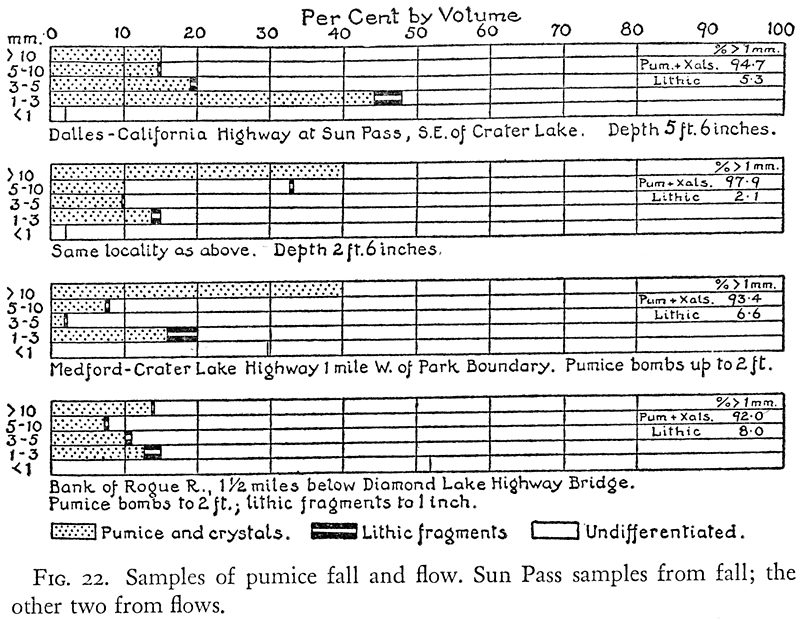In a general way, as might be expected, the pumice becomes finer away from Crater Lake, though the more the deposits are examined the more clearly it ears that this is indeed no more than a generalization. Commonly there is much more variation in a vertical thickness of a few feet than there is in many miles on the surface. Since, moreover, layers of a given coarseness and sorting can only be correlated over small areas; samples taken at random depths give a misleading picture. It should also be emphasized that the average coarseness does not by any means vary with the thickness of the deposits. Along the western fringe of the pumice fall, even where the thickness is less than 6 inches, lumps as much as 3 inches across are far from rare, though in other places nearer the source, where the thickness exceeds 2 feet, lumps more than an inch in diameter are exceptional.
Let it be repeated, however, that in general the pumice becomes finer with increasing distance from Crater Lake. Thus, as the histograms (figure 19) show, approximately two-thirds of the pumice that fell on Timber Crater, 8 miles from the center of the lake, consists of fragments more than 10 mm. in diameter. On the west slope of Mount Thielsen, 14 miles from the source, the percentage of such fragments is 62; near Miller Lake, on the east side of Thielsen, 21 miles from the source, the percentage drops to 25; near Windigo Pass, 25 miles from the source, it is 15; and on Skookum Butte, 30 miles away, the percentage is 18. Still farther from Crater Lake, the proportion of large lumps diminishes more rapidly. In the samples represented by figure 21, hardly any of the ejecta reach 10 mm. across.
The largest pumice lumps are to be found on Timber Crater, where many exceed 6 inches in maximum dimension, and a few reach a length of 8 inches. Lumps up to 4 1/2 inches across may be collected as far as 30 miles from the source, on Skookum Butte and Walker Rim. Even 40 miles to the northeast there are occasional lumps 3 inches across. Seventy miles distant in the same direction, pieces between 1/2 and I inch in size are not uncommon. Clearly, most of the large lumps were drifted to the north and northeast, and were products of the later eruptions, just preceding the pumice flows. During the earlier and weaker activity, the winds blew eastward, and therefore the pumice in that direction is much finer. Even on the hills near Kirk, lumps more than 2 inches across are far from abundant. On Boundary and Lookout buttes a few pieces measure 3 inches across, but around Wocus Bay, between 20 and 32 miles from Crater Lake, the percentage of lumps more than 1/2 inch in diameter ranges between zero and 13 (see histograms, figure 20).


